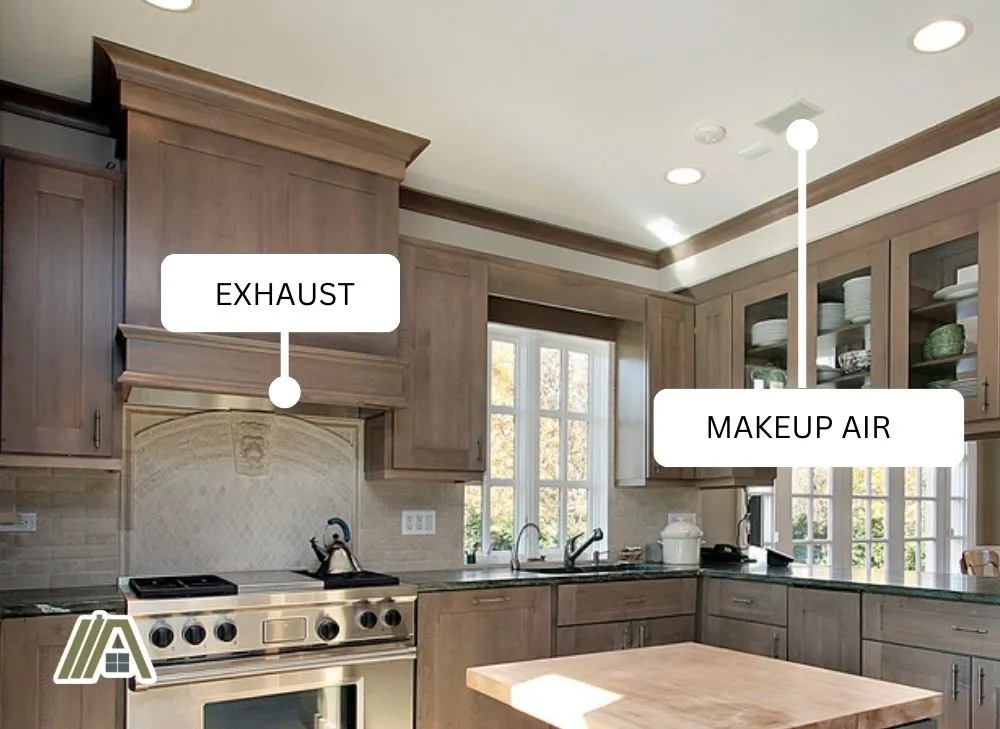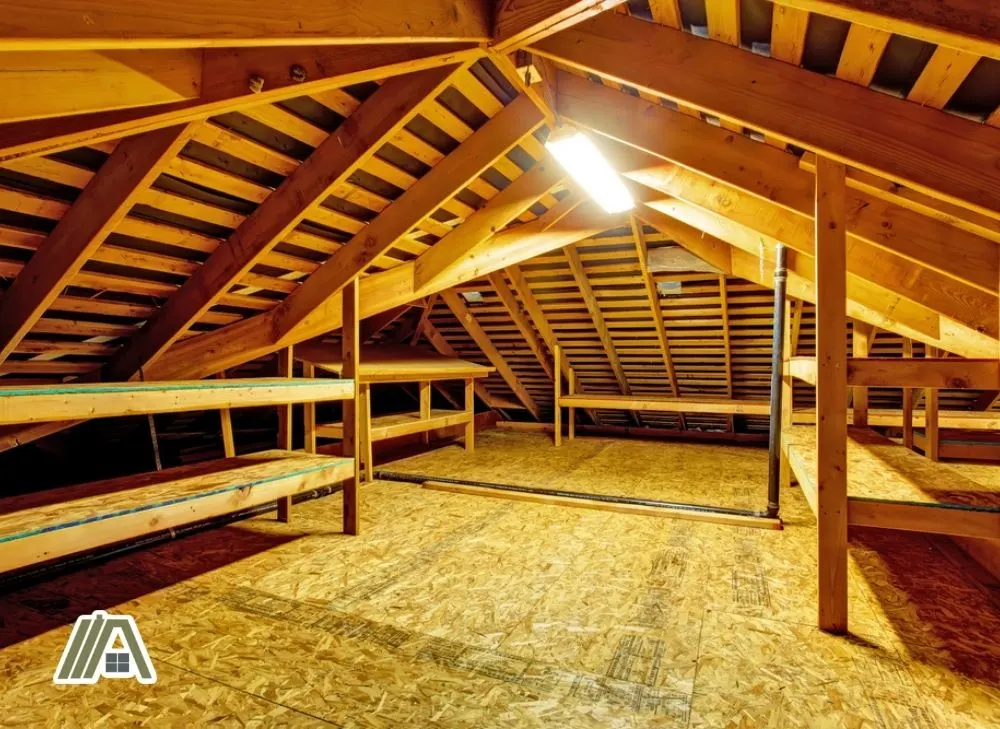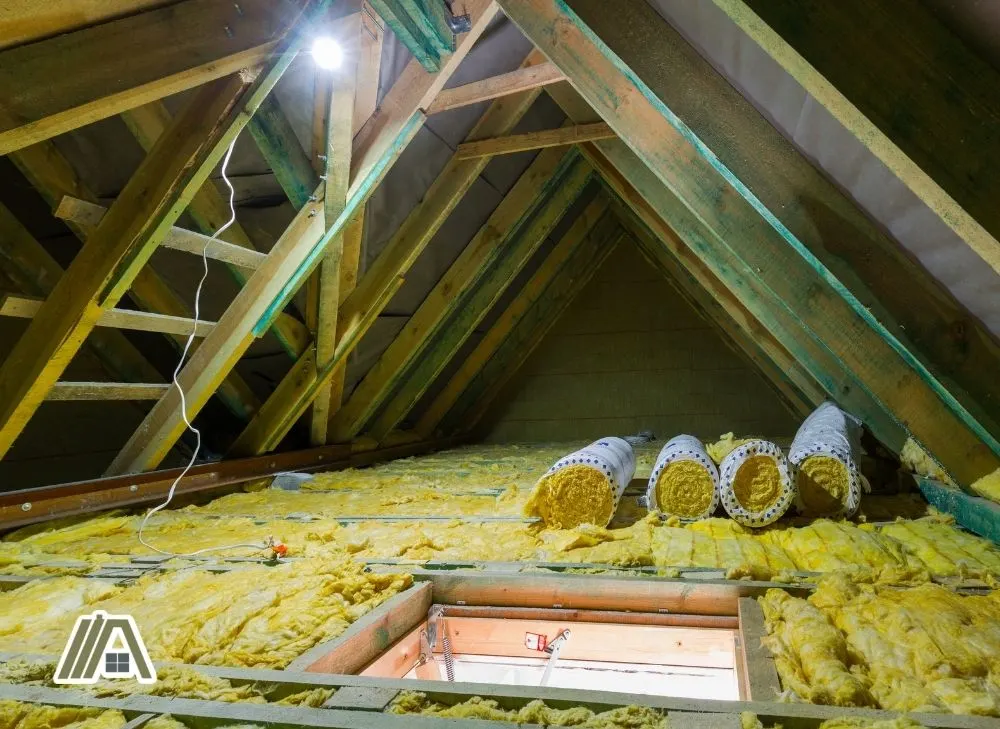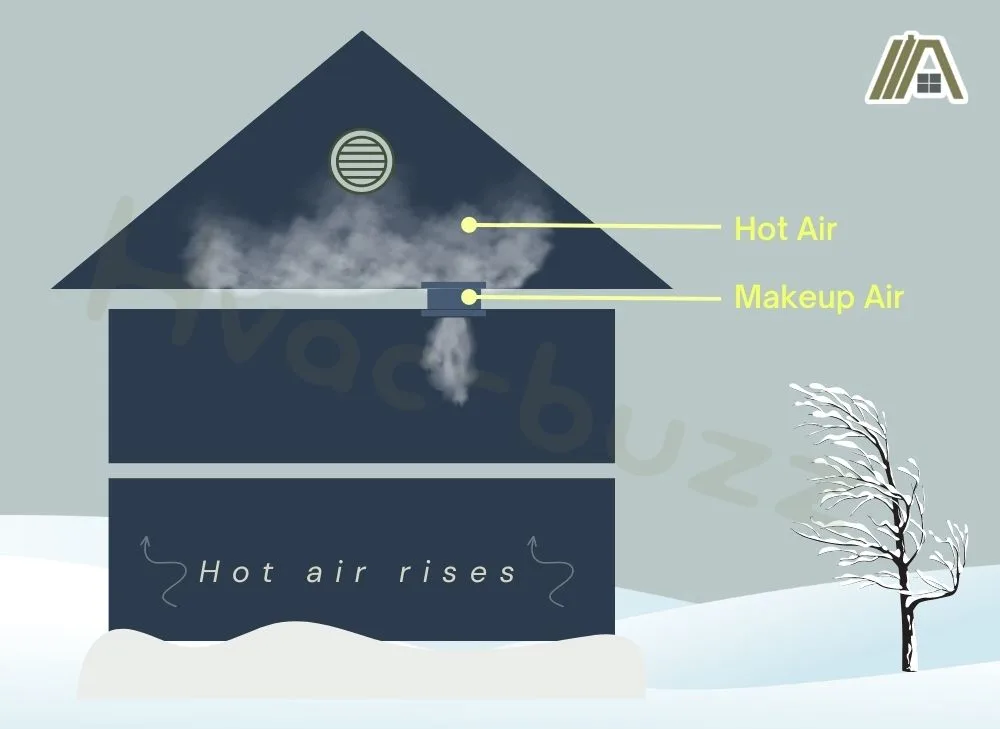It seems that the more you learn about home ventilation, the more holes through your roof and walls you end up with. Some holes, like your bathroom fan vent, are unavoidable, but the same may not be true for your makeup air vent.
While drawing makeup air from the outside is the most common method (and arguably the best), the attic may be a viable and legal alternative, depending on your setup and how you weigh the pros and cons of this approach.

The IRC does not prohibit pulling makeup air from the attic. It says that makeup air can come from outside and/or be transfer air, which is air pulled from another place in the house.
Makeup Air and the IRC
The International Residential Code (IRC) is the one that we look at for domestic homes (excluding apartment buildings). It is applicable in all American states and territories except for Wisconsin.
IRC regulations pertaining to makeup air are scattered through several chapters of this document. For example:
- Section M1503.6 considers makeup air and exhaust equipment for domestic cooking appliances. If at least one fuel-burning appliance exists in the home’s envelope and there is a 400+ CFM exhaust system present, then makeup air is required.
- Section G2407.4 dictates that makeup air is needed when exhaust fans, clothes dryers, or kitchen venting systems impede other appliances’ functioning. We assume this to mean gas appliances considering that is the subject of chapter 24.
- Section G2407.9.1 says that makeup air is required when gas appliance combustion air is supplied mechanically.

- Section G2439.5 necessitates makeup air for dryers that exhaust 200+ CFM.
However, as far as I can tell, there is only one section in the IRC where it talks about where this makeup air can come from.
Section G2403 provides a definition of makeup air, which includes the fact that it can be drawn in from the outside, it can be transfer air, or it can be made up of a mixture of both.
What Is Transfer Air?
Transfer air can basically be defined as air that has been supplied to a room from an open space within the house.
Typically, this open space will need to be supplied with air relatively freely through openings with the outside or connections to the HVAC system.
Taking Air From the Attic Is Not Prohibited
So, when looking at the IRC sections described above, there doesn’t seem to be anything that indicates makeup air coming from the attic is prohibited.
In addition, air coming from the attic would fall into the category of transfer air, which is part of the definition of makeup air.
That being said, there are two things to consider before going ahead with this approach:
- It may be prohibited by your local codes. Local codes make the IRC fully applicable in each state, which has differing laws, climates, economic standing, etc., and local codes trump the IRC when it comes to which code to follow.
- There are distinct problems and benefits to drawing makeup air from the attic. You must decide what you are willing to live with or handle.
Problems With Makeup Air From the Attic
Attic Air Can Get Hot
One thing that is important to be aware of is that the air inside attics can get very hot. If makeup air is brought in from the attic, hot air might be getting pumped into the home.
Pulling hot air into your conditioned rooms can negatively impact your own comfort.

Attics can reach temperatures over 100 °F in the summer. Pulling hot air into your conditioned rooms can negatively impact your own comfort.
Furthermore, it’s not just your comfort that would be affected. The influx of heated air into a temperature-regulated zone would also cause your HVAC system to work harder to maintain the temperature at which your thermostat is set.
Imagine leaving your windows open on a hot day but still running the air conditioning. It’s a similar scenario with attic makeup air.
The result would be greater energy usage, which is not very eco-friendly, and higher utility bills at the end of each month.
There is yet another drawback to this situation, one which is slightly less obvious but can turn out to be the most inconvenient and costly.
The harder your HVAC system works, the shorter its lifespan is. Your repair/replacement timetable will shift up and you may have to fork over hundreds or thousands of dollars long before you should be.
Dirt and Insulation Fibers Pulled Into Room
Makeup air from an attic could also pull in undesirable debris.
An unfinished attic would have an especially high chance of letting insulation and dust get pulled into the living areas of your home if this is where your makeup air was coming from.
Not only is this annoying to anyone who has to clean up the mess, but it could also cause problems for the occupants’ health.
Fiberglass, a common form of home insulation, is made up of fibers that are fairly dangerous when inhaled.
Fiberglass insulation lines attics, and in the case of unfinished attics, the insulation may be uncovered. As such, it would be quite easy for fibers to be brought into the room/space along with the makeup air.
Fiberglass insulation fibers that are inhaled can damage lungs and cause respiratory problems.
A similar problem can arise with the dust and debris that might be pulled into the home. Such things could cause allergic reactions and reduce the quality of one’s health, particularly if you have animal/insect infestation problems.

Outside Pressure Affects Attic Air Pressure
Storm patterns can create negative pressure cells outside of homes.
Negative pressure is most common with adverse weather like snow storms, thunderstorms, and rain. However, weather that isn’t typically considered “bad” can also bring negative pressure with it. Days that are cloudy and overcast or just very windy could also create areas of negative pressure.
Ventilated attics, i.e., attics outside of the building’s envelope, are easily affected by these external pressure cells.
Air always wants to travel from a point of higher pressure to a point of lower pressure. If a storm kicks up and creates a negative pressure system outside, then air in the attic, which has a comparatively high pressure, is pulled out through the ventilation openings.
This has a double effect on the exhaust system that is supposed to be supplied with makeup air from the attic.
Firstly, makeup air cannot be pulled from the attic into the room containing the exhaust system because it is already being pulled outside.
Secondly, the attic will be at a lower pressure than the rest of the house and will, therefore, draw air from the house. This can significantly worsen the drop in air pressure that your makeup air is supposed to be remedying.
This can create some serious problems for the rooms that need the makeup air, including backdrafting of combustion appliances, increased production of carbon monoxide, gurgling and smelly drains, and poor exhausting capacity.
Finished Attics Are Too Well-Sealed
Attics that are finished shouldn’t be used for makeup air because they are too well-sealed. They do not freely communicate with the outdoors, which means that the air you remove to be used as makeup air is not readily replaced.
You will, essentially, be exhausting air from your attic and creating a need for makeup air to be supplied to this room, and in the process, you are unlikely to be supplying reliable and sufficient air to the room containing the exhaust system.
Possible Benefits of Using Makeup Air From an Attic
Can Warm the House During Winter
In the colder months, warmth from the attic may be a welcome addition to the makeup air being supplied to a room.
While they won’t reach the same temperatures as they do in summer, attics are still warm in the winter because all the hot air in the house still naturally rises.

On the other hand, if the outside air is much colder than the air in the attic, the heat quickly moves down the temperature gradient, being lost to the outside air.
You’d have to assess your climate and house setup to see if you would benefit from this or not.
If you do, warm makeup air will add to your comfort without the added cost of heating the incoming air, and without increasing the strain on your HVAC system.
No Holes in the Roof or Wall
Makeup air systems that bring in air from the outside necessitate a hole cut into the roof or a wall. Makeup air from the attic only requires the creation of holes within the house.
While this might not sound much more appealing, it can really make a big difference.
Holes through your walls or roof are susceptible to leaks and they can also act as convenient pathways for insects or animals.
While unfinished, ventilated attics are not fully sealed against the elements, they are far more protected.
If you think about the amount of rain that can leak into your house through a vent leading outside compared to the amount from a vent leading to even a leaky attic, there really is no comparison.
Might Be Easier to Access for Repairs
Depending on the setup of your attic, how the roof is configured, and the location of the makeup air duct, repairs might be easier when makeup air comes from the attic rather than outside.
First of all, the ductwork is likely to be shorter. The less ductwork you have to deal with the less there is to develop issues.
Then, if problems do occur, particularly with the vent, then you don’t have to climb your roof or find a really tall ladder to access the side of your house with. You can just pop into the attic and make repairs or perform maintenance, even if it’s raining.
Moreover, if there is no direct access to the outside, there is less weathering of the makeup air vent, which also extends its lifespan.
Sources
https://www.finehomebuilding.com/2019/02/15/makeup-air-for-tight-houses
